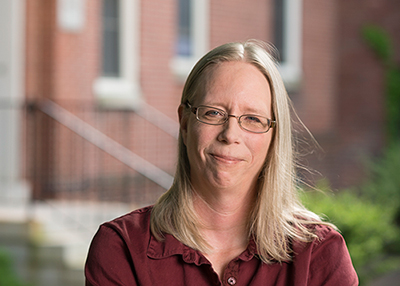Why I Became a Teacher

Peg Prentice began her career as a molecular cell biologist at the National Institutes of Health Cancer Institute. Today the 53-year-old Montgomery County resident is a science teacher at The Catholic High School of Baltimore and coordinator for its biomedical program. Her road from lab to classroom began 15 years ago when she noticed educational disparity in her government work.
At the time, her lab ran summer programs for some of the best and brightest high school students from Montgomery County schools. But what of the under-served schools, she wondered, and the kids who were interested learners but perhaps not top of the class? When her attempts to engage a more diverse student body in the lab’s youth outreach programs met with resistance, she quit on the spot.
“I found myself sitting on my back porch with one kid in college and another one about to be wondering what I was going to do with my life,” she recalls. “Then my best friend called and told me to apply for a job as a science teacher at a school in Baltimore City.”
At the time, the school did not require a teaching master’s degree or teacher certification. She did not explore a teaching program, instead choosing to leap right into her teaching career.
“I was going along, doing what I thought a teacher does and learning along the way,” she states.
After 10 years, she discovered a tuition assistance program offered by her school and decided to look at teaching programs that offered a teaching masters. When she researched graduate education programs at Loyola University she discovered the Master of Arts in Teaching (MAT). The Loyola program provided the flexibility she needed to continue working while pursuing her teaching master’s. She would graduate certified to teach, too.
“The information I was learning was amazing and I was literally putting it to use the next day in my classroom,” says Prentice.
Prentice explains that the 21st century classroom is completely different from what she recalled from her own youth.
“Obviously the technology is the biggest difference,” she explains. “[Students] have more technology on their hip than NASA had to land a man on the moon, and yet they aren’t very good at discerning what is useful or accurate.”
In the MAT program she was able to try various forms of new technology and see what would not only work in her classroom, but also bring value to the course work and not just be a piece of equipment in the room.
Perhaps the most important thing she learned through the MAT was how to differentiate among her students and meet them where they were in their studies.
“In the school where I was working at the time, we had kids who were all over the place,” she states. “We had students entering high school with fifth grade skills in reading and writing. I had no idea how to meet that need. Loyola helped prepare me for that.”
She credits Loyola with teaching her how to provide support and sometimes non-traditional learning opportunities for students who needed help. She also learned how to challenge high-performing students with substantive assignments and not simply by assigning them more volume of the same work. The ability to differentiate goes hand-in-hand with Loyola’s commitment to embedding an understanding of social justice in its MAT curriculum.
“The understanding Loyola provides of social justice is critical in today’s classroom,” Prentice says. “Not every kid speaks English, not every kid goes home at night and has dinner with two or even one parent, not every kid has had adequate high school preparation,” she says. “We get kids who have been home schooled, we have kids who get bullied – Loyola is very good at reminding you that you are not teaching a subject, you’re teaching students.”
Prentice found the program so beneficial, she became an “evangelist” for the MAT, encouraging her fellow teachers to pursue the Loyola degree. While the school did not require it at the time, she predicted – correctly – that there would soon be a demand for her peer educators to undergo teacher certification in Maryland. More importantly, she states: “Why would you turn down the opportunity to become the best teacher you can be?”
Now 15 years into her teaching career, Prentice has never looked back and wished she’d stayed in the government lab. Nothing can compare to the relationships she’s nurture through her teaching career. “That’s something Loyola really emphasized, too, the importance of getting to know students and build relationships with them,” she states. “If you do that right, a kid will never quit on you.”
For more information about the program visit our MAT frequently asked questions page.